With another year almost behind us, it’s time once again to structure goals for the new year. For a while now, the Atomic design team has taken to gathering for an annual planning session prior to the year’s end. We discuss our accomplishments, community involvement, professional development opportunities, and more. However, before we can formulate a plan to attack our goals, we first take time to review and reflect on all we’ve done the past year and, of all those accomplishments, to determine which we were most passionate about (and which gave us a case of the blahs).
From these collaborative sessions, a loose framework has emerged. So we present to you the Atomic Vision Board, a means of determining what comes next, professionally and with purpose.
The Atomic Vision Board
Typically we’ve completed this board in Mural, but of late we’ve switched over to Miro. You could also easily create this as a Post-it note or whiteboard activity. Pick the format that works best for you and your teammates. Speaking of which, this activity can be done individually or as a team. We’ve found, though, that more really is the merrier when it comes to filling out vision boards. Others’ ideas can be a great source of inspiration and offer opportunities to tag-team or collaborate on goals.
Also, as always with any type of design thinking framework, this is meant to be edited and added to as works best for you. We’re constantly updating and improving our activities the more we do them, each iteration a betterment of the last.
This is the entire vision board at a glance:
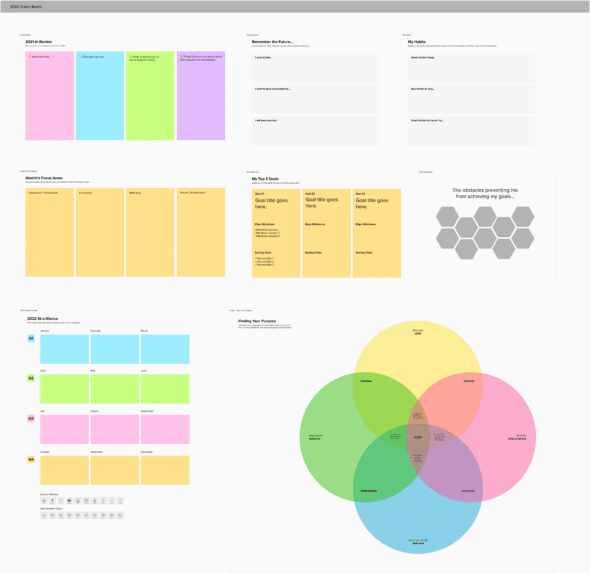
Here’s a breakdown of each section:
1. A Look Back: Your Past Year in Review
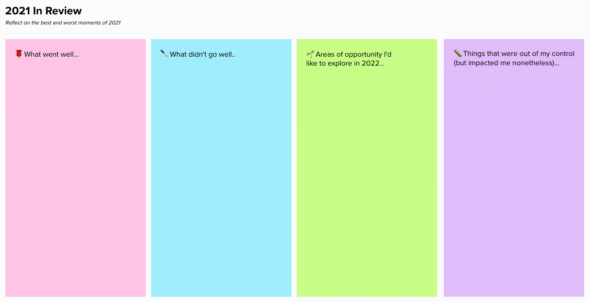
This activity is your basic Rose, Bud, Thorn, and this time the focus is you. The first two sections are pretty straightforward; “What went well…” and “What didn’t go well…” Reflect back on your highs and lows from the year. The following section is “Areas of opportunity I’d like to explore in {the year ahead}…” This could include things that caught your eye but that you didn’t have a chance to dive deeper into.
Finally, the last section is “Things that were out of my control, but impacted me nonetheless…” This is a particularly important section relevant to our current times. It allows room for grace. Sure, you may have wanted to complete that certificate, but lack of childcare stole all your free time. Or maybe you had high hopes to travel to that conference abroad, but the pandemic made that an impossibility. Give yourself grace and accept that sometime life gets in the way of our goals.
2. A Look Ahead – Remember the Future
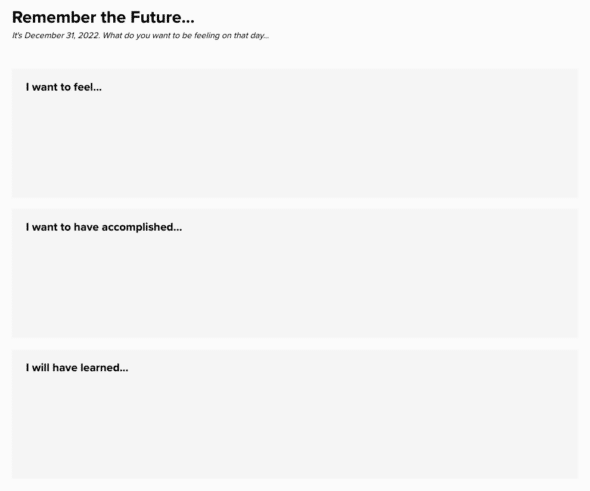
Now that we’re done looking backward, it’s time to zoom into the future. Remember the Future is an imagination-activating method that helps us frame our hopes for our future accomplishments.
The exercise is simple; imagine it’s December 31 of the next year. On that day, how do you want to feel, what do you want to have accomplished, and what will you have learned? The answers to these questions will help you in the sections ahead.
3. My Habits
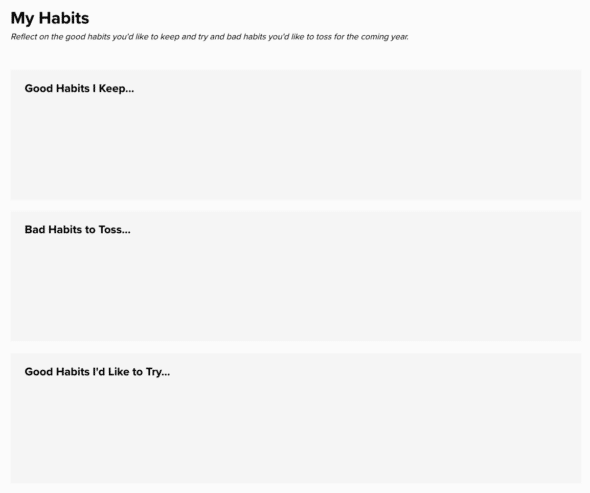
This section will give you a chance to take stock of how you think and act and how that may or may not impact your goals. Reflect on the good habits you’d like to keep, new habits you’d like to try, and bad habits you’d like to toss for the coming year. Examples could be keeping a journal, drinking more water, writing more thank you notes, reading a book a month, limiting social media use, etc.
4. Career Focus Areas
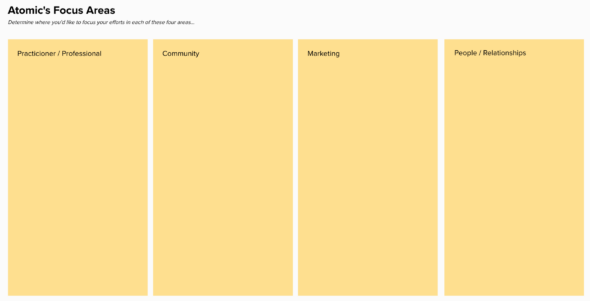
At Atomic, we have a way of breaking down the type of work we do into four specific categories: practitioner/professional, community, marketing, people/relationships. We fill in each of these areas to determine how we’ll contribute across categories in the coming year. We also keep a close eye on keeping tasks balanced and not overfilling our proverbial professional plates. For example, some of us will go deep in one category and back off on tasks in another, or we’ll have a balanced couple of tasks in each.
Here are more detailed descriptions and question prompts for each category:
Practitioner/Professional:
- What responsibilities or opportunities do I want to pursue in the future?
- What professional capabilities will support my longer-term career goals?
- Examples:
- Cross-discipline training
- Communication: Presentation, writing, facilitation, etc.
- Emotional intelligence
- Stress management
- Time management
- Business and financial acumen
Marketing:
- What conferences might I speak at this year? Can my blog posting efforts build collateral for a conference talk?
- What outreach and philanthropy opportunities might I want to support?
- How can I help marketing better understand my role and the value it brings to the company and our clients?
Community:
- How might I grow or maintain my personal and professional networks? Does connecting with other professionals help me frame my career goals and progress?
- What professional or community groups should I participate in?
People/Relationships:
- Do I have mentors or coaches inside or outside of {my company} to help me know myself and support my goals?
- Should I build new relationships based on my goals?
- Are there other colleagues I should meet with periodically to help stay socially connected, grow my skills, or support my growth path? What colleagues can I help with their own career growth (if asked or if my help is wanted/expected)?
5. Your Top 3 Goals
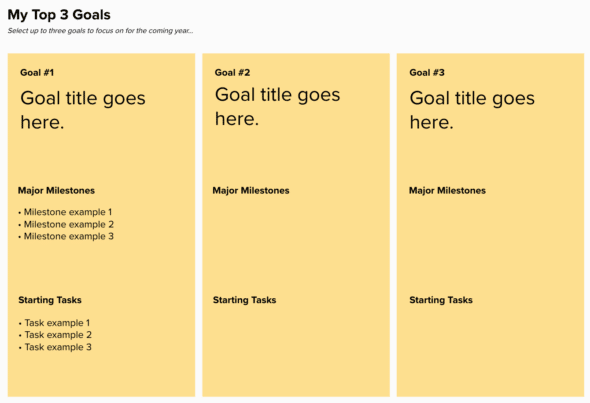
Now that you have a deep understanding of your past year, your hopes for the year ahead, your working habits, and your career dreams, it’s finally time to plan! Taking all your newly acquired insights, you can now begin to carve a path to higher-level goals.
In this section, there is room for three goals, but we don’t require all three to be filled. Some teammates may have one BIG goal, while others will want to tackle three smaller ones. Another way to structure it might be that your larger goal can break down into two to three more manageable milestones. Either way, do what works best for your plan.
When structuring your goals, here’s a bit of advice: Choose something that scares you a little or feels a bit out of reach. It shouldn’t scare you in that it’s dangerous or unhealthy but in the sense that you have some doubt that it can happen. An example might be setting a goal to be published in a popular magazine or blog or applying to speak at a TEDx conference. Set something that is truly a challenge for yourself. It will make the accomplishment feel that much sweeter and your confidence in yourself that much higher.
Two important attributes of this portion of the vision board are defining the major milestones and starting tasks for each goal. Sometimes it can be easy to determine the goal, but it’s hard to know where to start. It becomes helpful to list the first steps towards completing your goal so that you can have a clear starting line. Similarly listing a handful of major milestones on the way can make the goal feel more achievable.
6. Obstacles
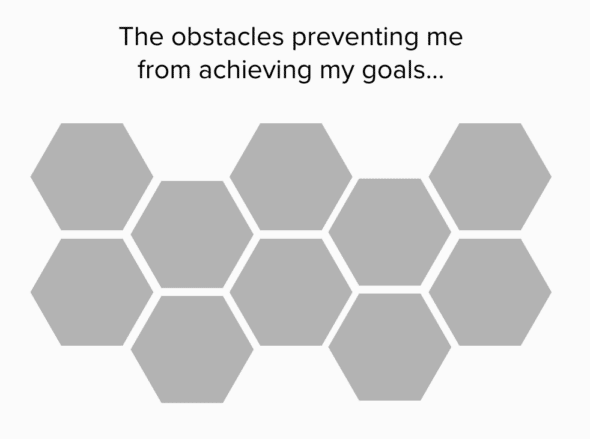
Nothing worth doing is without risks or obstacles. Therefore, it’s important to know the pebbles that might trip us or the boulders that will block our progress. Examples of these could be lack of time, resources, or energy, the inability to say “no,” or something as simple as a tight deadline. Each hexagon should contain one obstacle though not every hexagon has to be filled.
7. The Next Year at-a-Glance
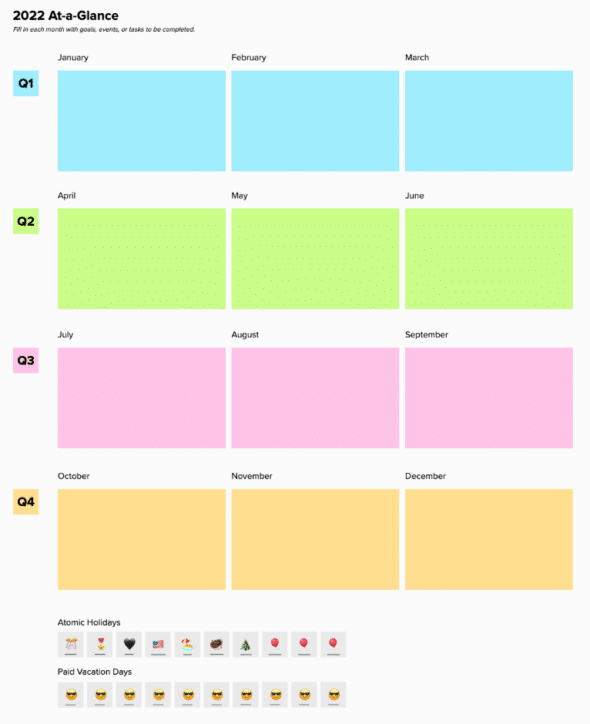
Now that you’ve made all those fancy, shiny new goals, it’s time to map out the tasks and milestones to the year’s calendar. It’s also important to consider where you’ll weave breaks and vacation time into that plan and where other cornerstone events or professional development opportunities might fall.
First, list out all your plans for goal tasks and milestones. Then after that, layer on your currently planned vacations and company or personal events or responsibilities. Though the calendar doesn’t have to reflect every little last detail, it will give you a great plan to work toward and a visualization of the year ahead.
8. Ikigai: Finding Your Purpose
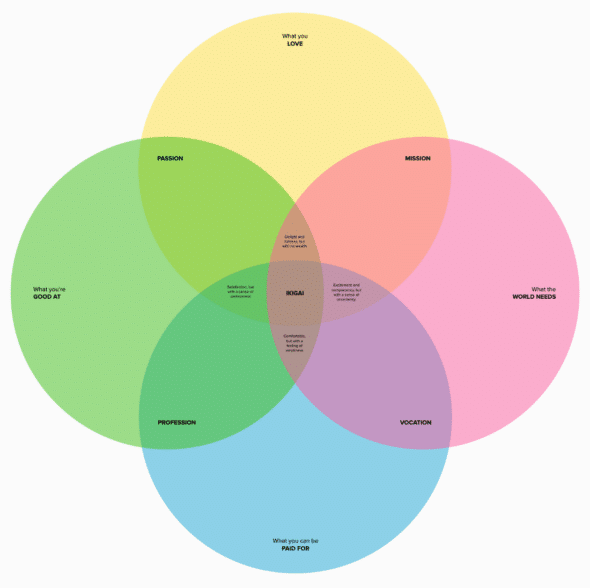
Ikigai (pronounced ee-key-guy) is a Japanese framework, something like a treasure map for seekers searching for their true passions and purpose in life. As smartly said by an NYPost journalist, “If hygge is the art of doing nothing, ikigai is the art of doing something, and doing it with supreme focus and joy.”
To learn more about this framework and the “rules” associated with it, check out this book, this blog post, or this video. Though the rules are an interesting read, I don’t emphasize them while completing the vision board. Instead, we focus more on the content that will go in the rings and how they intersect with each other.
Finding one’s purpose in life is not something I expect anyone to accomplish in a tiny annual planning session. If anything, this portion of the vision board should be done slowly, over a leisurely amount of time when one has the space to really think and drill into the core of their life. There’s also something to be said for completing this part of the board first, before any of the other sections, as it can provide invaluable insights into your work ahead.
Also, you may not want to complete your ikigai chart with colleagues as some of the content may be too personal or private. Work on it whenever and however makes you feel most comfortable and encourage others to do the same. The more truthful, based in reality, and complete the chart is, the better the outcome.
Vision Board Complete!
And that’s a wrap on the framework. Please let us know in the comments how you plan your year ahead and if you’ve tried out this framework. May this new year bring you joy and prosperity!

